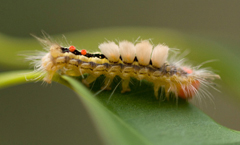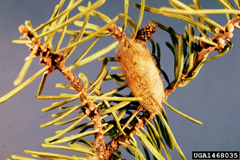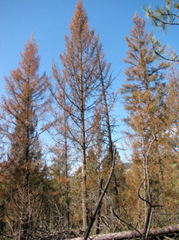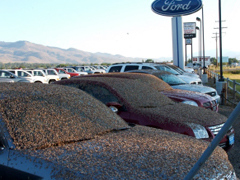Common Name
Douglas-Fir Tussock Moth
Latin Name
Orgyia pseudotsugata
Order
Lepidoptera
Family
Lymantriidae
Main Host(s): Douglas-Fir (Pseudotsuga menziesii), Grand Fir (Abies grandis), Subalpine Fir (Abies lasiocarpa), White Fir (Abies concolor), and less frequently on Ponderosa pine (Pinus ponderosa), Eastern Larch (Larix occidentalis).
Life Cycle
The Tussock Moth is native to the forests of western North America producing one generation a year. After overwintering, the eggs hatch in spring (May to June) and begin to feed on the foliage. Larvae are wasteful feeders; they feed initially on the current year’s foliage and may feed on older foliage as they grow older and larger until late July or August. Larvae may vary from light to dark brown in color with a row of red spots (tubercules) along their backs.
The larvae are very colorful with four white rust-tipped tussocks and strong white spines along its back, two pencil-like tufts of black spines in the front of the thorax and at the end of the abdomen.
The larvae complete four to six instars from late June to early August, depending upon location and elevation. They then pupate within a cocoon of silken webbing mixed with larval hairs on foliage, trunks or even on the sides of buildings. The adults emerge 10 to 15 days later in early-mid August. The female moth is unable to fly and she remains on top of her cocoon, attracting male moths by emitting a strong sex pheromone. After mating, each female lays approximately 200-300 eggs in a single mass on or near her empty cocoon; the tussock moth overwinters as an egg in the egg mass and hatches the following spring.


Impact & Damage
Outbreaks usually occur every 10 to 12 years and typically last for two to four years. Severe defoliation by the Douglas-Fir Tussock Moth may results in rapid tree mortality due to extremely high levels of defoliation. The larvae are wasteful feeders and consume the base of needles of both new and old foliage discarding the rest. Extensive defoliation can cause significant impacts on individual tree (top-kill) and forest health (growth reduction). Surviving stands are invariably in a weakened state, and very susceptible to other insects (such as the Douglas-Fir Beetle) and fungi.Additionally, about 20% of people and animals are allergic to Douglas-Fir Tussock Moth hairs. These hairs are present on the larvae, the cast larval skins, the egg masses, the cocoons, and the female moth. These urticating hairs may cause an allergic reaction called tussockosis to people, pets and other animals.

The symptoms of the tussockosis range from itching, skin rashes, and eye irritation to anaphylaxis in extreme cases depending on the severity of the outbreak, degree of exposure, and the sensitivity of the individual.Additionally, in extreme cases, large numbers of male moths swarm at nights around buildings and street searching for females. While not harmful, these flights create a nuisance for residents and businesses alike.

Resources
Learn more about Douglas Fir Tussock Moth
Quick Links
Contact a Valent BioSciences public health representative.
Contact Us